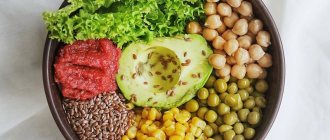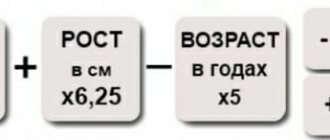Proper balanced nutrition is the basis for a person’s well-being, beauty, slimness, strength and even success in life. After all, what we eat determines what we do and how we look. A proper balanced diet, in turn, is based on the correct ratio of proteins, carbohydrates and fats in the product.
This article will cover the following issues:
- Proteins are the building blocks of the body
- Fats are sources of energy for humans
- Carbohydrates - nutrients
- Balance of proteins, fats and carbohydrates in the diet
- BZHU when distributed for breakfast, lunch and dinner
- How to correctly calculate KBZHU
- Calculation of KBZHU using a specific example
- An easier way to calculate KBZHU
It is very important to understand everything and use scientific information for your benefit. In this regard, we will now tell you what substances a person needs every day and in what proportion. And KBJU will help us. This is a common abbreviation for "calories, proteins, fats, carbohydrates." These are the ones we will learn to count.
Proteins are the building blocks of the body
It’s not for nothing that proteins are called the building blocks of the body. According to the great original design, they participate in the formation of all the cells of our body. It is proteins that are responsible for the construction of our organs, muscles, blood vessels, skin, and so on. In addition, they transport oxygen and nutrients to organs and tissues, promote the production of certain hormones and enzymes, and remove toxins from the body. Thus, all people need proteins, and the attitude towards them should be appropriate.
They must be in the diet not only of athletes, as some may think, but also of people losing weight. Moreover, it is proteins that allow you to feel full and overcome the feeling of hunger. Also note that the body does not accumulate the substances discussed, so a person must receive them constantly, and not from sunlight, but with food.
Where can I get proteins? They are found in animal and plant products:
- in animals - meat, dairy products, eggs and fish;
- in plants - beans, mushrooms, nuts.
Well, it is clear that plant foods will be absorbed better than animal protein. Moreover, in principle, our body does not need protein itself, but what it consists of - amino acids.
How much protein should you eat daily? According to scientists, the average daily protein requirement is:
- for women – 1.3 g per kg of weight,
- for men – 1.5 g per kg of weight.
And if a person experiences serious physical activity, then it is recommended to add another 0.2 g to these figures. Oddly enough, if you want to lose weight, it is also recommended to increase your protein intake by the same amount - by 0.2 g. But keep in mind: that more than 30 g of protein per meal is not absorbed by the average person. The larger volume will not go into the accumulation of useful protein, but will go – you know where. In two places - in deposits on the body, and for some reason fat, and also in the toilet. Moreover, too much protein negatively affects the functioning of the kidneys, stones may appear in them, and calcium, which we really need, will be excessively removed from the body. It also turns out that with a lack of protein, a person also begins to have serious health problems.
Protein deficiency can be detected by:
- weight loss,
- stunted growth in children
- decreased immunity,
- disruption of the thyroid gland, gonads, adrenal glands,
- dry skin,
- brittle hair and nails.
Don't torture yourself with low-fat milk
And low fat too. Remove restrictions on cheese; in terms of calcium, it is better than milk (calcium from milk is not absorbed at all and even increases the risk of fractures, as shown by a large-scale Harvard study).
Is this such a bold and fantastic step? In my opinion, to eat cottage cheese with 0.5% fat content you need to have cosmic willpower. Don't avoid sour cream in your soup, sprinkle cheese on your meat casserole, don't dress your salad with yogurt (unless you SINCERELY like that option better, but in any case, there are 10% Greek yogurts in the world, not 2% pale infirmities). By the way, if yogurt is associated with fruits or grains, try the option with olive oil and bacon. And for a berry dessert, use sour cream or mascarpone cream.
But remember that dairy products are highly individual, and they do not always have a place at the weight loss stage.
Fats are sources of energy for humans
Fats are also important nutrients for humans. As sources of energy, they come in second place after protein. Fats are water-insoluble compounds containing glycerol and fatty acids. With their help, fat metabolism occurs in the body, without which life could not exist. Therefore, even on the most strict diet, they cannot be abandoned, especially for a long time.
What do fats do in our body?
- produce energy, heat;
- ensure the absorption of vitamins A, D, E, K, which will not dissolve without fat and will not bring benefit to a person;
- make the walls of blood vessels more elastic, which guarantees better receipt of nutrients from the blood;
- support immunity;
- form and strengthen the nervous system;
- make skin and hair beautiful and healthy.
But fats are different from fats. There are both useful and harmful. It is not recommended to eat all fatty acids in a row.
The following types of fats are distinguished:
- Saturated. They can be obtained from butter, milk, meat, lard and so on. Within reasonable limits, they can be useful, but if you overeat, they very quickly lead to a set of extra pounds.
- Unsaturated. These are the most beneficial fatty acids for humans. They are divided into monounsaturated, which are found in vegetable oils, olives, avocados, and so on, and polyunsaturated, which are present in seeds, nuts, and fatty fish.
- Trans fats. They are substances harmful to the body. There is no benefit from them, but the blood vessels are thoroughly clogged with harmful cholesterol. They are formed in fried vegetable oil, which is present in abundance, for example, in fast food.
With a lack of fat, the following appear:
- liver and kidney diseases;
- increased swelling,
- reduced immunity,
- disruption of the hormonal system,
- dry skin,
- dull and lifeless hair.
However, in turn, excess fat in the diet ensures the appearance of:
- cardiovascular diseases,
- excess weight.
Scientists define the average daily fat intake for a person as 1-1.5 g per kg of weight. It is clear that with a low-active lifestyle you will need a little less of them, and with increased physical activity - a little more. The main thing is that these are mainly unsaturated fats, but it is better to avoid trans fats altogether when leading a healthy lifestyle.
Tips for those who want to calculate the daily calorie content of their diet as accurately as possible
- Keep a food diary where you write down all your meals, including snacks. Don't rely on your excellent memory, it often fails. All calories consumed must be recorded and accounted for. Only then will you get the most accurate result at the end of the day.
- Buy a kitchen scale; do not determine the weight of food by eye. Small errors result in a noticeable difference in the final calorie content of the daily diet.
- Weigh food before cooking.
- Consider the calorie content of butter, sauce, sugar and other auxiliary products in the dish.
- Place on the scale only that part of the product that will be directly consumed as food (boneless meat, pulp of fruits and vegetables without peels and seeds, eggs without shells).
- Don’t look for the calorie content of a multi-ingredient dish on the Internet and mobile apps, calculate it yourself. Before cooking, weigh the ingredients, calculate their energy value and add up the results. The final data will be more accurate.
- Try to avoid eating at food establishments. The calorie content of the dishes on the menu is very approximate. Only you can calculate the KBZHU for yourself as accurately as possible.
Carbohydrates - nutrients
Carbohydrates, along with proteins and fats, are also necessary elements of our existence. That's how we are made. Therefore, you should never give up eating carbohydrates. These are nutrients that are mostly made up of sugars. This group includes glucose, fructose and sucrose. The main purpose of carbohydrates is to provide the body with energy. This is where we get approximately 40% of our fuel.
We need these substances for normal functioning:
- brain,
- nervous system,
- cardiovascular,
- kidney,
- hormonal system,
- cartilage tissue.
With a lack of carbohydrates, a person experiences:
- constant feeling of fatigue,
- lethargy, apathy,
- irritability,
- decreased immunity,
- swelling,
- hormonal imbalances,
- problems in the functioning of the heart and vascular system.
In general, all this is serious. And low-carbohydrate diets can, without much difficulty, be useful only for literally a few days, and then the lack of carbohydrates in the diet will be fraught with serious consequences. However, enumerating the components under discussion is not helpful. Everything is good in moderation. Carbohydrates can accumulate in the body.
Excessive amounts of carbohydrates in food lead to:
- obesity,
- diabetes mellitus,
- increase in blood cholesterol levels,
- atherosclerosis.
In this case, all carbohydrates are divided into two groups:
- Simple carbohydrates. They are also called fast carbohydrates, since they are broken down faster than other carbohydrates due to their simple structure, are absorbed faster and quickly increase the level of glucose in the blood. They usually give themselves away easily with their sweet taste. These include sugar and all confectionery products that contain it in large quantities, almost all fruits and berries, and some sweet vegetables, for example, beets and carrots. Simple carbohydrates can quickly fill a person, but only for a short period of time.
- Complex carbohydrates. Their second name is slow. They are also often called starchy. They take longer to break down than simple ones, and do not cause sudden surges in glucose. With their help, you don’t feel like eating for a long time. This is the most preferred carbohydrate option for nutrition. Cereals (buckwheat, oatmeal, pearl barley, etc.), legumes, corn, and durum pasta are rich in slow carbohydrates. Also, such products are rich in starch, which gives these carbohydrates the name starchy.
In addition, dietary fiber also belongs to complex carbohydrates. They are not digested, but without them the gastrointestinal tract cannot function normally.
Nutritionists recommend, depending on the goal, to have the following amount of carbohydrates per kg of weight in the daily diet:
- under normal conditions – 3-4 g,
- when losing extra pounds – 2-3 g,
- when gaining muscle mass – 5-6 g.
What foods should form the basis of the diet?
Squirrels
- Lean meat (chicken, turkey, beef, rabbit).
- Eggs.
- Cottage cheese.
- Whole grain.
- Dairy products.
- Fish.
- Legumes.
- Green leafy vegetables.
- Nuts.
Fats
- Vegetable oils (olive, corn, sunflower, flaxseed).
- Avocado.
- Sea fish.
- Seeds.
Carbohydrates
- Durum wheat pasta.
- Whole wheat bread.
- Honey.
- Legumes.
- Vegetables and fruits.
Particularly dangerous for your figure are monosaccharides or fast carbohydrates contained in sweet drinks, confectionery, as well as trans fats - there are many of them in processed foods, chips, hamburgers, margarine, store-bought sauces, and sausages.
Balance of proteins, fats and carbohydrates in the diet
As you can see, proteins, fats and carbohydrates are necessary for the body, and everyone should have them in their diet. However, their value is determined not only by quantity, but also by proportion in relation to each other.
The balance of BZHU provides the body with adequate nutrients and prevents excess weight gain
The ideal ratio of proteins, fats and carbohydrates in nutrition remains a mystery to scientists. Still, our body is wonderfully designed. But there are approximate numbers here. For a long time, Russian doctors recommended adhering to the norm of 1:1:4, where proteins, fats and carbohydrates come in order. That is, in this proportion every day a person needs to eat proteins - 16.6%, fats - 16.6%, and carbohydrates - 66.6%. And only relatively recently, experts have proven that such a norm is fraught with serious troubles for the body, since there is a clear imbalance - too many carbohydrates and not enough proteins. The result was disastrous: the weight increased, not decreased, and the energy and strength became less and less. Draw conclusions.
Currently, the Ministry of Health of the Russian Federation proposes as the only correct optimal ratio of BZHU as 1.2: 1: 4.6. In percentage terms these are 18%, 15% and 67%.
Recommendations on BZHU from the Research Institute of Nutrition of the Russian Academy of Sciences are also interesting. The norms for an ordinary person per day for proteins are 25-35%, fats – 25-35% and carbohydrates – 30-50%. They explain the range in numbers by different diets for people, depending on their gender, age and lifestyle, which is very logical.
In addition, we recommend paying attention to the version of the World Health Organization: 18%, 25% and 57%. Still an international standard. Although it is clear from Covid that the WHO also often changes its recommendations over time to the exact opposite.
You can find very different standards from doctors here, but you still got approximate figures.
In any case, the diet should contain:
- a little more than half of all food should be allocated to carbohydrates, let us remind you that these are mainly cereals, fruits, and vegetables;
- give approximately a quarter of the diet to fats, which include meat, lard, dairy products, vegetable oils, nuts, seeds, fatty fish;
- Approximately a fifth of the food should be allocated to proteins, which include meat, dairy products, eggs, fish, beans, mushrooms, and nuts.
But! Such norms apply if a person’s weight is normal and he does not set a goal to lose weight. However, when trying to remove extra pounds, the optimal ratio of BZHU will be 40%, 30% and 30%. That is, the emphasis here is also on vegetables, fruits and cereals, and then we dilute the diet by about a third with protein and fatty foods.
When gaining muscle mass, the proportions will be 35%, 30% and 55%. Training requires a lot of energy, and these are carbohydrates, as well as proteins from which muscles are created.
But this proportion will work effectively after a person has gotten rid of excess fat in the body, and only then begins to build up a muscle corset.
Make a normal omelet
There is no “extra” yolk in an omelet – there is only a missing one. It’s easy to get rid of the habit of removing the yolk; it’s harder to get used to adding another one. On keto, the balance of not only carbohydrates, but also proteins is important, so sometimes it is better to leave two yolks and one white. Add an avocado smoothie to this and a hearty breakfast is ready. If you stick to the whites, you can use three yolks for two whites. This is a good option if for some reason you can't add cheese or cream to your omelet. And if you can, too. A great option is to mix the devil’s eggs and spread the fatty filling into not all halves of the egg white.
Yolk is a great way to quietly make your child's diet more balanced. Mark Sisson has no bad advice.
BZHU when distributed for breakfast, lunch and dinner
Thanks to science, we also have access to the normal ratio of BZHU distribution throughout the day. That is, if before this we gave you recommendations on the amount of protein, fatty and carbohydrate foods that are simply normal for 24 hours, but now we want to tell you how to properly distribute all this for breakfast, lunch and dinner.
Breakfast. It is believed that in the morning a person needs to be energized and given more carbohydrates. However, there is an opinion that the body is just waking up in the morning and is not ready for serious nutritional loads. Therefore, for the first breakfast it is better to eat something light - such as a salad of fresh vegetables, fruit or drink a smoothie to start the gastrointestinal tract. And for the second breakfast (after 1.5-2 hours) you can already load yourself with carbohydrates. For example, cottage cheese with fruit, whole grain muesli, and everyone’s favorite scrambled eggs are good options. But this is, of course, if circumstances allow you to divide the food for the first and second breakfast.
Dinner. In the middle of the day, it is better to eat proteins, fats and carbohydrates in equal proportions. Just beware of trans fats and fast carbohydrates. Ideal here would be, for example, buckwheat or brown rice, a piece of white meat or fish, and a delicious vegetable salad. Moreover, there may be a big difference in presentation in terms of weight and volume. Do not forget that cereals and meat will be smaller in volume than lettuce leaves of the same weight. Therefore, meat and cereals together should take up about half of the plate, and vegetables should be given the other half of the dish.
Dinner . In the evening, some experts advise it is better to reduce the amount of carbohydrates, but increase the amount of protein. But this again depends on what time you have dinner.
This recommendation is worth accepting if your last meal is before 18.00, but eating a large amount of, for example, meat at night will not be beneficial.
In general, in terms of calorie content, nutritionists advise deviating from the daily value:
- for breakfast – 25%,
- for lunch – 35%,
- for dinner – 20%,
- for snacks – 20%.
Pay attention to the universal advice. If you eat a piece of meat or fish with any vegetables (raw or stewed), sprinkled with high-quality vegetable oil, or add another quarter of a plate of cereals, then in terms of proteins, fats and carbohydrates this will be the ideal ratio in one meal. You definitely can't go wrong here.
Add butter
It will brighten up any dish. Steamed fish cutlets are bae, but with a piece of butter they are a gastronomic delight. Throw a couple of cubes into stewed vegetables to make the stew more hearty - and you no longer need potatoes. This is not deliberate fattening of food; we have been cooking this way since the advent of butter. And before the advent of steamers, margarine, and chemically produced vegetable oils.
How to correctly calculate KBZHU
People who lead a healthy lifestyle are well aware of the abbreviation KBZHU. But, if we have already understood BZHU (proteins, fats, carbohydrates) well, here they are supplemented with another letter K - calories. It turns out that you can’t go anywhere without them either. The correct ratio of proteins, fats and carbohydrates alone will not get you far. All this still needs to be balanced in terms of calories. Otherwise, we’ll just overeat and gain even more excess weight.
Let's learn to calculate KBJU. First, we will show you this using mathematical formulas, and then we will show you how you can make such “mathematics” much simpler.
To calculate the KBZHU we need such basic human parameters as:
- Weight, kg.)
- height (cm)
- age (years)
First, we calculate the amount of energy that a person spends at rest, simply to keep himself alive, during the work of all internal and external organs. There are two formulas commonly used here. In practice, for calculation accuracy, you can apply them simultaneously. The result is in calories.
Formulas for calculating KBZHU at rest:
- Harris-Benedict formula. 655.1 + (9.6 x body weight in kg) + (1.85 x height) - (age x 4.68).
- Mifflin St. Jeor formula. 10 x weight + 6.25 x height + 5 x age - 161.
The resulting number is usually in the range of 1200 to 1400 kcal. And the difference in calculations according to the formulas, as a rule, does not exceed 100 calories.
Now is the time to figure out what we have calculated. It turns out that this is the value below which a person cannot consume calories. At least for a long time. Otherwise, the harm to health will be significant.
Physical activity rate. Determined based on the type of work:
- during sedentary work – 1.2;
- with sedentary work and light training up to three times a week – 1.3;
- when working on your feet full time – 1.5;
- with sedentary work and moderate-intensity training four times a week – 1.4;
- when working on your feet and intense sports – 1.6;
- with sedentary work and playing sports five times a week – 1.6;
- with heavy work on the legs and intense sports five times a week – 1.9;
- among housewives – 1.3;
- for housewives who work in the garden – 1.5.
Then we multiply the basic amount of calories obtained above by the specified physical activity coefficient, which is most suitable for a particular person. The result is a figure that shows the number of calories needed per day for the normal functionality of the body.
If you want to become slimmer, you need to subtract 10% from this value, and then the resulting figure will already exist with a calorie deficit for weight loss. You can, of course, reduce it by 15 or 20%, but lower is not recommended. Especially if we are talking about a long-term restriction in the intake of the necessary calories.
At the last stage of calculations, we need to apply the BZHU ratio that is already known to us. For 100%, take the resulting daily amount of required calories and divide it in proportions, for example, into the WHO format of 18%, 25% and 57%. And if we are talking about an overweight person, then the option 40%, 30% and 30% is suitable.
But in order for the calculation to be completely completed, it is necessary to convert the resulting result from calories, which mean the energy value of food, into grams of food, which are more understandable to us.
Calories to grams ratio:
- 1 g of fat - 9 calories,
- 1 g of protein - 4 calories,
- 1 g of carbohydrates contains 4 calories.
To do this, you need to divide the calculated number of calories by the number of calories in 1 g of proteins, fats or carbohydrates. And then stick to the received numbers in your diet.
Percentage ratio of BZHU
It is recommended to maintain a balance of 30–20–50. Proteins should make up 30% of your daily diet, fats 20%, and carbohydrates 50%. It is also useful to introduce low-carb days, when the amount of carbohydrates does not exceed 15-20% of the total diet.
If you want to lose weight, you need to stick to a certain number of calories. The average calorie intake for a person who wants to maintain their weight is about 2000. If you want to lose weight, it is considered safe to gradually reduce by 500 calories. It is not recommended to lose weight by more than 2–4 kg per month. Also, calculating calories when losing weight must take into account the level of physical activity of a person. It is not recommended to lower calories below 1200: this can affect your physical and emotional well-being.
shutterstock.com
Calculation of KBZHU using a specific example
Let's show the calculation of KBZHU using a real example. Let's take an average woman of 46 years old with a body weight of 73 kg and a height of 160 cm. According to the Harris-Benedict formula, she needs approximately 1440 calories per day.
We calculated it like this:
655.1 + (9.6 x 73 kg) + (1.85 x 160 cm) - (46 years x 4.68) = 1436.62 calories.
We will do the same using the Mifflin-Saint-Geor formula.
10 x 73 kg + 6.25 x 160 cm + 5 x 46 years – 161 = 1799 calories.
Approximately 1800 calories. And if we also average this with the figure obtained when calculating using the previous formula, then the required value will be 1600 calories. The figure is, of course, average, but it cannot be any other way. After all, this is not an individual, but a very average, in general, calculation.
Now let's imagine that the woman we are counting on has a sedentary job, but at the same time does moderate-intensity training four times a week. This means her physical activity coefficient will be 1.4. That is, her daily calorie intake will be 1600 calories x 1.4, which is approximately equal to 2200 calories.
But, judging by the initial data, it would not hurt for her to lose weight by 10-15 kg, which means that the number of calories she has can be safely reduced by 10%, which will ultimately amount to 2200 calories x 0.9 = 1980 calories. In this case, we got 0.9 as (100% - 10%)/100.
That is, as a result, she will be recommended to eat no more than 2000 calories per day.
Now is the time to get to proteins, fats and carbohydrates. Since our lady from the example needs to get rid of extra pounds, let's use the proportion of BZHU for weight loss - 40%, 30% and 30%.
Calculation of BZHU for weight loss based on the amount of 2000 kcal:
- protein = 2000 calories x 0.4 = 800 calories,
- fat = 2000 calories x 0.3 = 600 calories,
- carbohydrates = 2000 calories x 0.3 = 600 calories.
At the last stage, all that remains is to convert the calculated calories into grams:
- protein = 800 calories: 4 calories = 200 g,
- fat = 600 calories : 9 calories = 66.7 g
- carbohydrates = 600 calories: 4 calories = 150 g.
The calculation is over! Now it becomes clear how much our average woman needs to eat to lose weight. It’s just not clear how she can survive on such grams per day. But this is a joke.
We calculated the nutrients in their pure form, but there is also fiber, liquids, etc. They can be used to fill up the rest of the food.
In addition, we have received an excellent reason to think about how we overeat in everyday life, because in principle we need very little food to maintain our vital functions.
Forget about milk
When you read life hacks about reducing calories in your diet, there is almost always a point “replace the cream with skim milk.” In principle, there are many questions about milk, and lactose is the same as sugar. By the way, lactose-free milk is one in which the lactose has already been broken down into simpler sugars, so that’s not an option either.
Low-fat milk makes little sense, and low-fat milk is beyond good and evil. If you don't like black coffee, why not add cream instead of milk and sugar - and a richer one? It’s tasty and, if this is important, then in the long run it’s less caloric – after a rich coffee, you don’t want something tasty an hour later. And after coffee with milk - almost always. For the most daring, there is an option with butter - armored coffee.
Choose meat with normal fat content
If someone foams at the mouth and proves that chicken breast is delicious, the unfortunate person is lying to himself. Another thing is duck breast. Veal steak. And the lamb?! Eating chicken alone is not only depressing - it is unhealthful; its abundance in the diet leads to a skew in the ratio of Omega-6 and Omega-3 towards the former, although their healthy proportions are 1:1. If you choose chicken, then the fatty parts are the legs and thighs. By the way, don’t be afraid of bacon or salami if they don’t contain sugar or complex additives. And of course, you should try to take meat and poultry from farms, free-range and free-range, the difference will be obvious.











